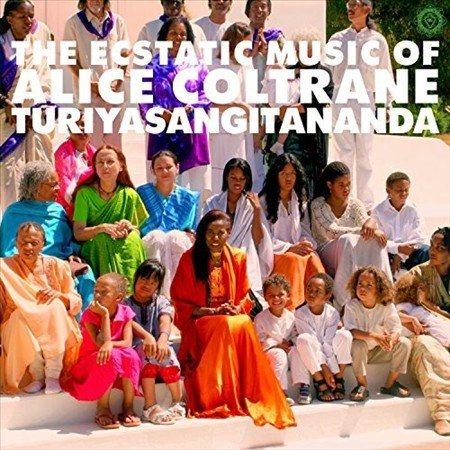Alice Coltrane
WORLD SPIRITUALITY CLASSICS 1: ECSTATIC MUSIC
WORLD SPIRITUALITY CLASSICS 1: ECSTATIC MUSIC
Couldn't load pickup availability
The title of this record is evidenced by the very first notes of opening track "Om Rama." A chorus of chanters armed with hand claps and tambourines light into a Hindu Bhajan, accompanied by Alice Coltrane's whirling Wurlitzer organ as she lays down brooding bass notes with one hand, moves her feet across those pedals with authority, and plays glissandi synth with the other hand -- immediate ecstasy. Then John Panduranga Henderson -- who sang with Ray Charles -- delivers a moaning, gospelized solo as Coltrane vamps on his blues. This isn't common Hare Krishna chanting, folks. This music is compiled from four privately pressed cassettes (Turiya Sings [1982]; Divine Songs [1987]; Infinite Chants [1992], and Glorious Chants [1995]) that Coltrane distributed to members of the Sai Antaram Ashram (which she founded) between 1982 and 1995. Some were recorded in professional studios; all were engineered by Baker Bigsby -- who oversaw the tape transfers here from the masters -- and represent a startling chapter in her musical legacy. The music exists in the space where "ecstatic" meets "heavy." Coltrane, known to her followers as Turiyasangitananda ("the Transcendental Lord's highest song of bliss"), brought all of her musical history to bear in these pieces, from her beginnings playing piano in the churches of Detroit and the hard bop she played there to Paris and New York, to the vanguard, which she embraced with openness and helped to redefine with a softer, more spacious approach.
The most amazing aspect of this music is what few have heard before: Coltrane's very deep and physical singing voice; her lead vocals are featured on most of the album, and it's another instrument she commands (though she wouldn't see it that way). On "Om Shanti," she accompanies herself on organ using breath control in an airy, devoted chant. On "Rama Rama," sarod, tablas, and her Oberheim synth add blissful dimensions to her quietly passionate singing. "Keshavas Murahara" commences with strings (her chart), Oberheim, and droning organ; her voice emerges as if from smoke, slowly intoning the prayer, dirge-like, but jazz informs her phrasing as the synth winds around her voice. The first half of "Journey in Satchidananda" features only her organ and Oberheim. It's droning, bluesy, and heavy -- nearly Gothic. When the Ashram Singers come in and Joshua Spiegelman adds a flute, some light enters. Tamil singer Sairam Iyer solos in his own language, opening the heart of the chant and bringing it home. Harp makes its presence felt on "Er Ra," where Coltrane's playing moves across Eastern and Western modes as her singing emerges in sweet, blues-inflected lines. Luaka Bop did everything right for The Ecstatic Music of Alice Coltrane Turyirasangitananda, from getting full participation from her family to create an amazing package with a great long essay by Ashley Khan, to reminiscences, to excellent sound. This is not just ecstatic music, but cosmic soul music. If you buy one archival recording this year, let this be it. ~ Thom Jurek
- RSD Release Date: DDD
- Genre: Folk, World, & Country
- Format: Vinyl
- Released: 05/05/2017
Shipping
Shipping
Global Shipping
Insured Heavy-Duty Packaging
Return policy
Return policy
We offer a 10-day from delivery, no-hassle return or exchange policy. To contact us or read more, click HERE.


